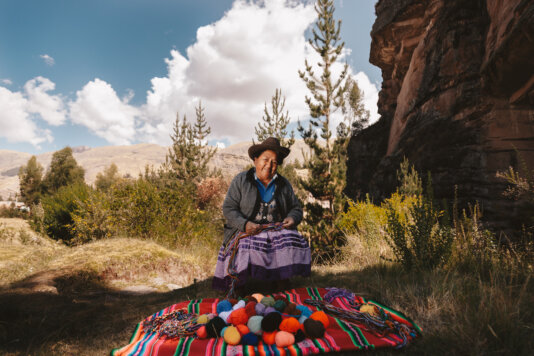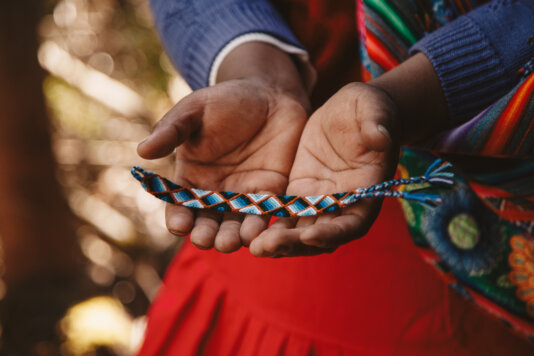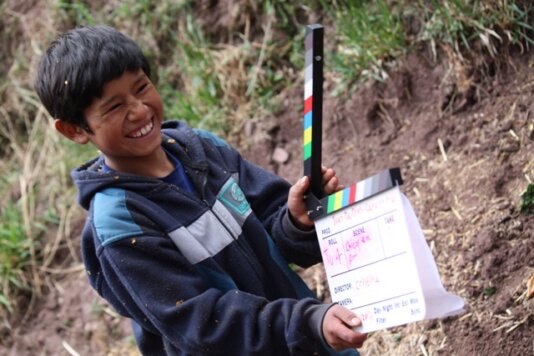- About
- Topics
- Picks
- Audio
- Story
- In-Depth
- Opinion
- News
- Donate
- Signup for our newsletterOur Editors' Best Picks.Send
Read, Debate: Engage.
| August 08, 2023 | |
|---|---|
| topic: | Indigenous people |
| tags: | #indigenous peoples, #education, #poverty, #women's rights |
| located: | Peru |
| by: | Ellen Nemitz |
Marleni, a 28-year-old natural science educator from Peru, hails from Ccorca, a rural community located approximately one and a half hours away from the popular tourist destination of Cusco. She managed to graduate from Universidad Nacional San Antonio Abad del Cusco and dreams of becoming a leader in her home community.
Her chances of success have been increased though a partnership with Amantaní, an NGO that has been working with young people and their parents in Peru since 2008.
"Amantaní's projects helped me develop the capacity to be able to work and generate an income during my studies at university, even up to graduation," Marleni told FairPlanet. "Now I feel like a woman who is prepared, and feel proud of who I am."
Amantaní operates in various locations, including Cusco, Ccorca, Huanoquite, and certain districts in the Amazonian region. Their mission is to provide educational opportunities and promote financial independence for both young individuals and women in these areas. The project's leaders, Fred Branson, Pilar Echevarria, and Rocío Zúñiga, recognised an urgent need to support these communities when they encountered girls who had to endure arduous four-hour walks to attend classes. These girls faced risks such as sexual abuse and other forms of violence, in addition to challenging weather conditions and a lack of basic necessities for living.
Fifteen years ago, they began to provide shelter and improved the quality of classes, which were formerly recorded in video and are now held in-person. The NGO first did so for a small group of girls, and later on included boys as well.
In order boost these kids' chances of going to university, the NGO, which is headquartered in Cusco and Lima (Peru) as well as in the UK and Spain, developed additional projects granting fellowships to fund all their costs, for instance, and supporting the communities' economies.
One of these initiatives is Ethical Trade, through which over 40 artisans weave traditional Andean bracelets and hats to be sold in stores across Peru and the UK.
"All these women are linked to the young people who are studying in some way, be them mothers, sisters or aunts. The artisans are fairly paid by their job and the revenue supports the projects and helps pay for the studies of the young people, besides boosting women's financial independence," Rodrigo Bustos, Amantaní's executive director, told FairPlanet.
The work of Amantaní brings attention to a systemic issue in Peru: a stark disparity in the quality of education, particularly between urban and rural regions. Indigenous peoples, in this context, can be even more affected. Living in remote areas, they lack infrastructure and qualified teachers, as well as adequate access to bilingual education (most indigenous people in Peru speak Quechua) and schools that respect their cultures and ways of learning.
"Our teachers did not integrate our identity or the customs of our people into school teaching. I remember that classes were in Spanish, for example, and that was very difficult for us. As children, we didn't understand it," Hector Raul, an environmental engineering student and a fellow of Amantaní', told FairPlanet.
Furthermore, the long distances and the prevalence of violence act as additional barriers that keep children away from schools, claimed Patricia Ames, a doctor of philosophy and professor of Anthropology at the Pontificia Universidad Católica del Perú.
"Girls are often more excluded, as they are asked to cook, clean and take care of school facilities more than boys, while they are less encouraged to participate and take the lead in school activities, reinforcing traditional female roles related to house care," she added.
Access to higher education by indigenous populations is also remarkably low, Ames highlighted, and not only in Peru. According to UNESCO, while more than 71 per cent of non-indigenous people in Latin America were enrolled in tertiary education in 2019, the rate falls to 40 per cent when among indigenous groups.
In Peru, Ames said, around 34 per cent of Spanish speakers attend university, but rates are lower - 14 per cent in general and 8 per cent in the Amazon region - among those who only speak an indigenous language.
Bustos from Amantaní also emphasised the connection between the quality of lifelong education and the ability to gain acceptance into a university, stressing that academic performance over time plays a significant role in this process. Moreover, he added, young individuals often require psychosocial support to sustain their studies amid structural challenges such as poverty, child labour and racism.
"Even in Cusco, which is predominantly a city of indigenous people, they also discriminate a lot against people who come from [rural] communities because of the way they dress, their skin, their education, the way they speak," Bustos said. "There are many people who don't pass on the [Quechua] language [to their children] so that they won't be discriminated against in the city."
However, he also noted that there has been a recent recognition by the State of the importance of native languages, representing a positive development in the appreciation of Andean culture. This shift poses a significant challenge, even for indigenous communities, as they navigate the complexities of preserving their cultural heritage and languages within a broader societal context.
"Their cultural traditions are obviously lost over time, especially when they arrive in the city. What we, without forcing anyone, obviously, try to maintain is that the boys and girls feel proud of where they come from, proud of their origin and proud of their family, settling their identity so that they can develop in their professional, personal and working life."
Amantaní has discovered an effective method to foster a sense of pride in one's identity through the "Meet my World" project. This initiative involves creating a series of videos where young individuals showcase their daily lives and sources of happiness through their own perspective.
Amantaní is not alone in its endeavors, as other NGOs have also made significant strides in providing education to remote areas while considering the cultural and linguistic characteristics of the communities they serve. One notable example is the Programa de Formación de Maestros Bilingües de la Amazonía Peruana (Peruvian Amazon Bilingual Teacher Training Program) - a programme dedicated to constructing an intercultural pedagogy that applies critical pedagogical approaches, strategies and knowledge dialogue in line with an intercultural perspective.
Additionally, the REGS Network, in which Patricia Ames is actively involved, has been dedicated to analysing data to gain a deeper understanding of the wide-ranging factors that contribute to educational inequalities, particularly in the Global South. The network's aims is to identify the various experiences and initiatives that effectively dismantle barriers and combat inequalities, thereby promoting the right to education for different groups.
"NGO projects are a good way to show what may work better, try alternatives and initiate changes to contribute to empowering indigenous cultures and respect them," the researcher said.
Ames emphasised, however, that while NGOs play a crucial role, it is essential not to rely solely on their limited coverage. The government, she believes, bears the ultimate responsibility to ensure that every Peruvian child, adolescent and young individual has access to education. This responsibility includes respecting their culture and language in order to create inclusive educational opportunities that expand their prospects for success.
"The government needs to attend to equity as well as quality: unequal quality cannot be considered quality. More resources, better infrastructure and well prepared teachers are needed in rural areas," she claimed.
It appears that initiatives looking to solve Peru's education crisis will require more than good will. The experts point out that it is crucial to shift from an approach where certain institutions impose supposed solutions, often based on experiences from the Global North, to a cooperative model that values indigenous knowledge and actively listens to the voices of the communities themselves.
"[We have to] first soak ourselves in the knowledge of each of these communities and work together with them," explained Amantaní's director. "We usually think we bring the solution to the communities, but over time we have realised that the solution is there, we are only tools."
Image by Amantaní.
By copying the embed code below, you agree to adhere to our republishing guidelines.


